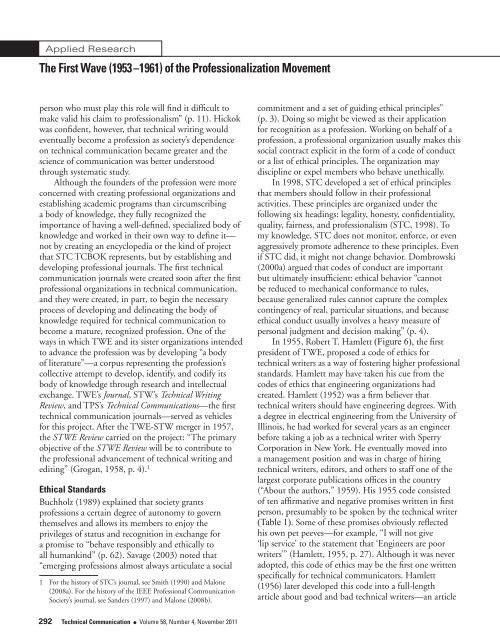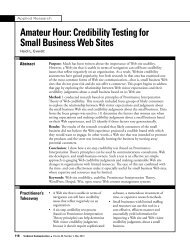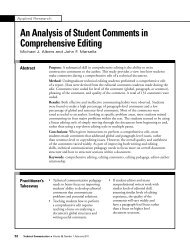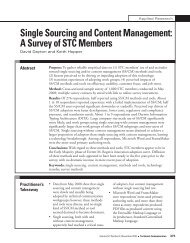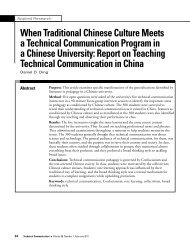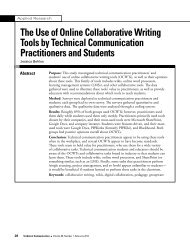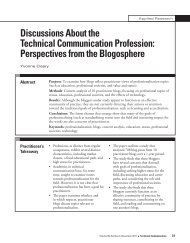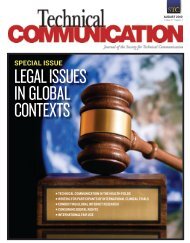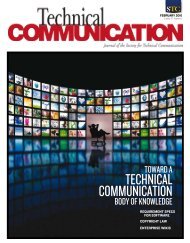SPECIAL ISSUE
Download: November 2011 - Technical Communication - Society for ...
Download: November 2011 - Technical Communication - Society for ...
- No tags were found...
Create successful ePaper yourself
Turn your PDF publications into a flip-book with our unique Google optimized e-Paper software.
Applied ResearchThe First Wave (1953–1961) of the Professionalization Movementperson who must play this role will find it difficult tomake valid his claim to professionalism” (p. 11). Hickokwas confident, however, that technical writing wouldeventually become a profession as society’s dependenceon technical communication became greater and thescience of communication was better understoodthrough systematic study.Although the founders of the profession were moreconcerned with creating professional organizations andestablishing academic programs than circumscribinga body of knowledge, they fully recognized theimportance of having a well-defined, specialized body ofknowledge and worked in their own way to define it—not by creating an encyclopedia or the kind of projectthat STC TCBOK represents, but by establishing anddeveloping professional journals. The first technicalcommunication journals were created soon after the firstprofessional organizations in technical communication,and they were created, in part, to begin the necessaryprocess of developing and delineating the body ofknowledge required for technical communication tobecome a mature, recognized profession. One of theways in which TWE and its sister organizations intendedto advance the profession was by developing “a bodyof literature”—a corpus representing the profession’scollective attempt to develop, identify, and codify itsbody of knowledge through research and intellectualexchange. TWE’s Journal, STW’s Technical WritingReview, and TPS’s Technical Communications—the firsttechnical communication journals—served as vehiclesfor this project. After the TWE-STW merger in 1957,the STWE Review carried on the project: “The primaryobjective of the STWE Review will be to contribute tothe professional advancement of technical writing andediting” (Grogan, 1958, p. 4). 1Ethical StandardsBuchholz (1989) explained that society grantsprofessions a certain degree of autonomy to governthemselves and allows its members to enjoy theprivileges of status and recognition in exchange fora promise to “behave responsibly and ethically toall humankind” (p. 62). Savage (2003) noted that“emerging professions almost always articulate a social1 For the history of STC’s journal, see Smith (1990) and Malone(2008a). For the history of the IEEE Professional CommunicationSociety’s journal, see Sanders (1997) and Malone (2008b).commitment and a set of guiding ethical principles”(p. 3). Doing so might be viewed as their applicationfor recognition as a profession. Working on behalf of aprofession, a professional organization usually makes thissocial contract explicit in the form of a code of conductor a list of ethical principles. The organization maydiscipline or expel members who behave unethically.In 1998, STC developed a set of ethical principlesthat members should follow in their professionalactivities. These principles are organized under thefollowing six headings: legality, honesty, confidentiality,quality, fairness, and professionalism (STC, 1998). Tomy knowledge, STC does not monitor, enforce, or evenaggressively promote adherence to these principles. Evenif STC did, it might not change behavior. Dombrowski(2000a) argued that codes of conduct are importantbut ultimately insufficient: ethical behavior “cannotbe reduced to mechanical conformance to rules,because generalized rules cannot capture the complexcontingency of real, particular situations, and becauseethical conduct usually involves a heavy measure ofpersonal judgment and decision making” (p. 4).In 1955, Robert T. Hamlett (Figure 6), the firstpresident of TWE, proposed a code of ethics fortechnical writers as a way of fostering higher professionalstandards. Hamlett may have taken his cue from thecodes of ethics that engineering organizations hadcreated. Hamlett (1952) was a firm believer thattechnical writers should have engineering degrees. Witha degree in electrical engineering from the University ofIllinois, he had worked for several years as an engineerbefore taking a job as a technical writer with SperryCorporation in New York. He eventually moved intoa management position and was in charge of hiringtechnical writers, editors, and others to staff one of thelargest corporate publications offices in the country(“About the authors,” 1959). His 1955 code consistedof ten affirmative and negative promises written in firstperson, presumably to be spoken by the technical writer(Table 1). Some of these promises obviously reflectedhis own pet peeves—for example, “I will not give‘lip service’ to the statement that ‘Engineers are poorwriters’” (Hamlett, 1955, p. 27). Although it was neveradopted, this code of ethics may be the first one writtenspecifically for technical communicators. Hamlett(1956) later developed this code into a full-lengtharticle about good and bad technical writers—an article292 Technical Communication l Volume 58, Number 4, November 2011


